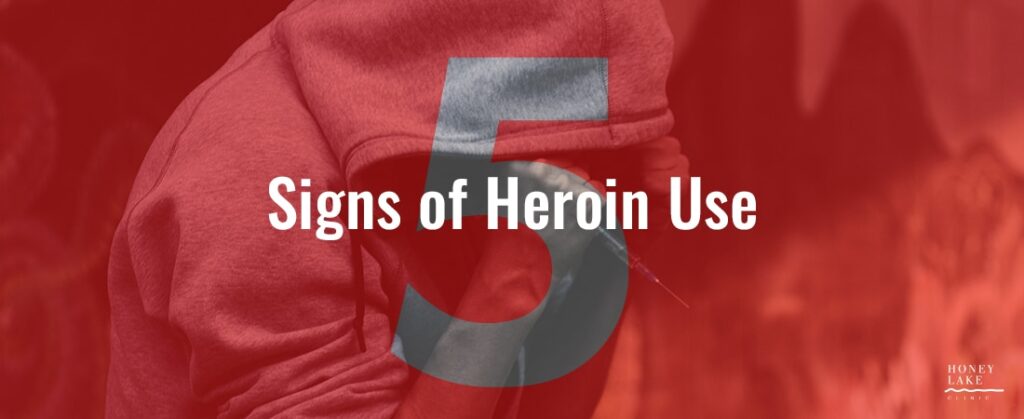5 Signs of Heroin Use
Heroin is quickly becoming the deadliest drug in the United States. Stories of heroin abuse, addiction and overdoses are in the news headlines every day. It is impacting families everywhere.
A powerful opioid drug derived from the opioid poppy plants, heroin is most commonly known in two forms, as a white or brown powder or as a black tar-like substance. It is injected, smoked, sniffed and snorted. Heroin is highly addictive, no matter what the form or how the drug is used. And—as evidenced in all those headlines—it is deadly.
If you’re fearful that your loved one has developed a heroin addiction, seek help immediately. Speak confidentially with a counselor right now. Make the call. (888) 837-6577.
The sooner a drug problem is identified, the faster a person can begin reclaiming their life through a comprehensive inpatient treatment program.
What should you be looking for?
Here are 5 Signs of Heroin Addiction:
1. Physical Signs
Physical signs of heroin use include immediate side effects and external signs of use. Some immediate side effects of heroin use can include a rush of euphoria, flushed skin, dry mouth, and a heavy feeling in the arms and legs.
Prolonged heroin use may cause external signs of use, or changes in appearance. Many people who abuse heroin don’t pay great attention to their personal hygiene or physical health. They may begin sleeping for long periods of time, experience other sleep troubles, or begin rapidly losing weight. Because heroin is often abused intravenously, people who regularly “shoot up” may wear long sleeves at all times to hide track marks, skin lesions or injection site infections.
If a person is an intravenous user they may have marks where they inject the drug, including:
- bruising
- scabs
- scarring
- unhealed needle marks
2. Behavioral Changes
Using heroin can cause behavioral changes due to changes in brain chemistry, rapid mood shifts, and the pressures of maintaining addiction or dependence. Once an addiction has formed, the person will begin aligning life activities with their drug seeking and use.
Maintaining addiction can become all-consuming. Avoiding withdrawal by constantly seeking the drug, telling lies or keeping secrets to hide your abuse, and trying to maintain life’s obligations while under the influence are just a few of the behavioral signs of heroin use.
3. Health Changes
Chronic heroin use causes many changes to overall physical health. A few changes that may be signs your loved one is using heroin include:
- Abscesses and other skin infections
- Chronic runny nose
- Constant nodding off (referred to as “going on the nod”)
- Dry mouth
- Itchy skin
- Small, constricted pupils
- Unexplained fatigue
- Weakened immune system
After the initial rush, or high, of heroin, a drowsy state can set in for several hours. Many users move back and forth between consciousness and unconsciousness while on heroin, alternating from a wakeful to drowsy state. This is called “going on the nod.” Going on the nod or slipping in and out of consciousness is a period that can precede overdose. All too often, heroin overdoses result in death.
4. Environment Changes, Living Conditions and Friends
In keeping up with an addiction, many people abusing heroin begin keeping company of others who are also abusing the drug and spend much or all of their time with these people. Your loved one may also let personal living conditions slip, much like declines in personal hygiene and health. Personal surroundings may become increasingly dirty or disorderly, or they may even begin leaving paraphernalia out in the open.
Before reaching the point of totally letting things go, they may go to great lengths to hide their drug use. This can include keeping things locked away, meeting drug use acquaintances or street dealers in private, and carefully covering their tracks.
5. Paraphernalia
At first, you may not find evidence of heroin use in or around your loved one’s personal things, but as addiction takes over their life, they may forget or even forego hiding the evidence. The following are some objects used for heroin abuse, or signs of current or recent use:
Items used for transporting or storing the drug:
- small baggies
- balloons
- foil squares
Items used for injecting the drug:
- a belt or rubber tubing (used as a tourniquet)
- burnt spoon or bottle cap (for liquefying the heroin)
- cotton balls (for filtering the drug)
- lighters
- syringes or needles
Items used for smoking the drug:
- burnt aluminum foil
- burnt pop can
- straw (for inhaling vapors from either of the above)
- pipe
Items used for snorting the drug:
- cut off, hollowed-out pens
- straws
- rolled dollar bills
- razor blades
- hard surface with powdery residue on it
Frequent abusers of heroin often keep these items in a small bag or case. This kit may be kept hidden in a vehicle, bedroom, bathroom or other personal space.
Does any of this look or sound familiar? Is someone you love struggling? We know it is scary. We can help.
At Honey Lake Clinic, we understand that substance abuse is a complex and dangerous mental health concern, affecting not only the one in its grip, but also others. Our experienced staff, licensed therapists, psychologists, and psychiatric specialists, strongly believe that faith-based treatment, encompassing mind, body and spirit, will provide you with the long-lasting tools and knowledge to find freedom from substance abuse.
A beautiful and tranquil 1300-acre lakeside setting, a safe medical environment, 24-hour nursing, doctors and psychiatric specialists, all administering care from a Christian worldview and perspective—Honey Lake Clinic is a unique solution in Christian mental health.
